大家好,我是Kethrine。今天要分享的是优质课听课笔记,来自第十八届全国高中教师教学基本功大赛—山西 王伊霖老师的现场授课。太喜欢这节听说课了,逐字稿是我自己敲出来的,记录逐字稿是为了学习,分享旨在一起进步,请勿商用,侵删~(文末附了word版网盘链接,方便大家学习)
第十八届教师基本功大赛-现场授课8-听说课
外研版 选必一Unit4 Listening and speaking
山西 王伊霖
T: Class begins. Good afternoon, boys and girls.
Ss: Good afternoon.
T: OK, sit down, please. Recently, I received an invitation from my best friend Jessie. She invited me to go to an art exhibition, themed “Meeting the Muse”. So I went there and I found the art of thereis quite astonishing. So I shot a video for you. Now let's enjoy the video, okay?
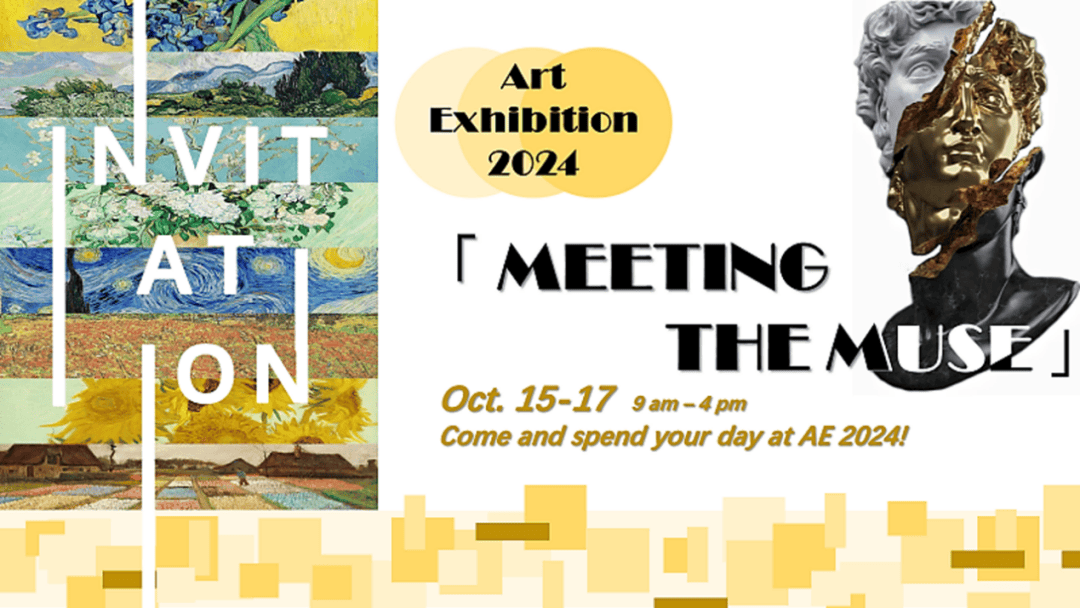
T: So from the video, we can see quite a lot of different forms of art, right? Such as film, painting, literature, and so on, right?We know artists always want to create something new, but where do artists get their inspiration from to create new things? Who or what inspiresthem? Do you know that? Who or what inspires them?
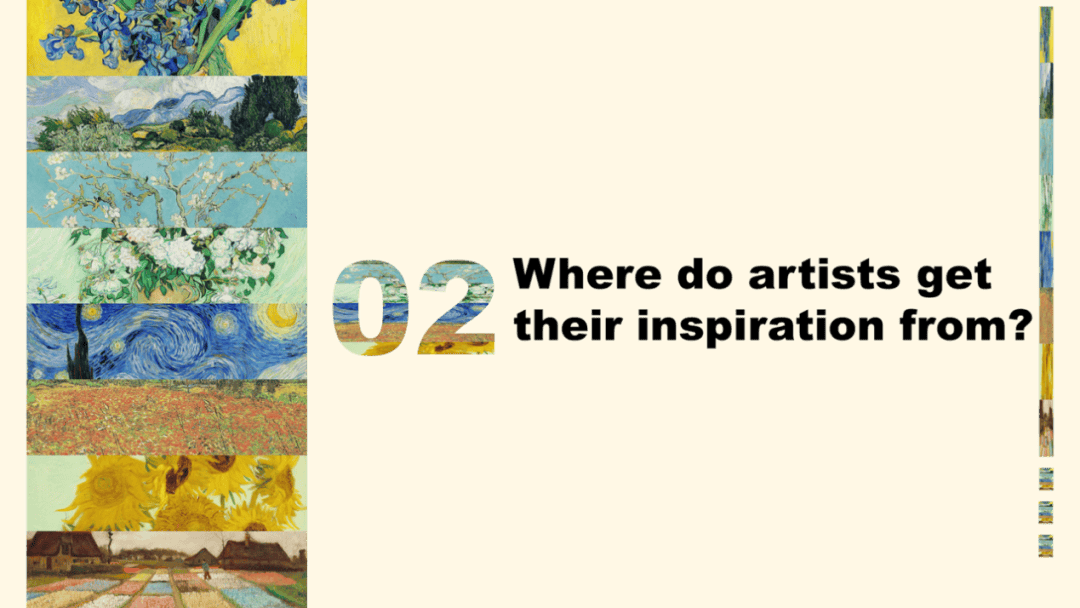
S1: I guess it's some very scenic thing.
T: Yeah, some scenic things mean some scenic spots?Okay, any other things?
S2: Something in life.
T: Yes, something in life. And?
S3: In our daily life, and some another picture?
T: Yes, some other pictures. That is to say, artists always get inspiration from different cultures, different people, different things or different aspects of life, right? Yes, and among them, one everlasting source of inspiration is war.Throughout the history, countless artists have been protesting wars and promoting peace through their artworks.

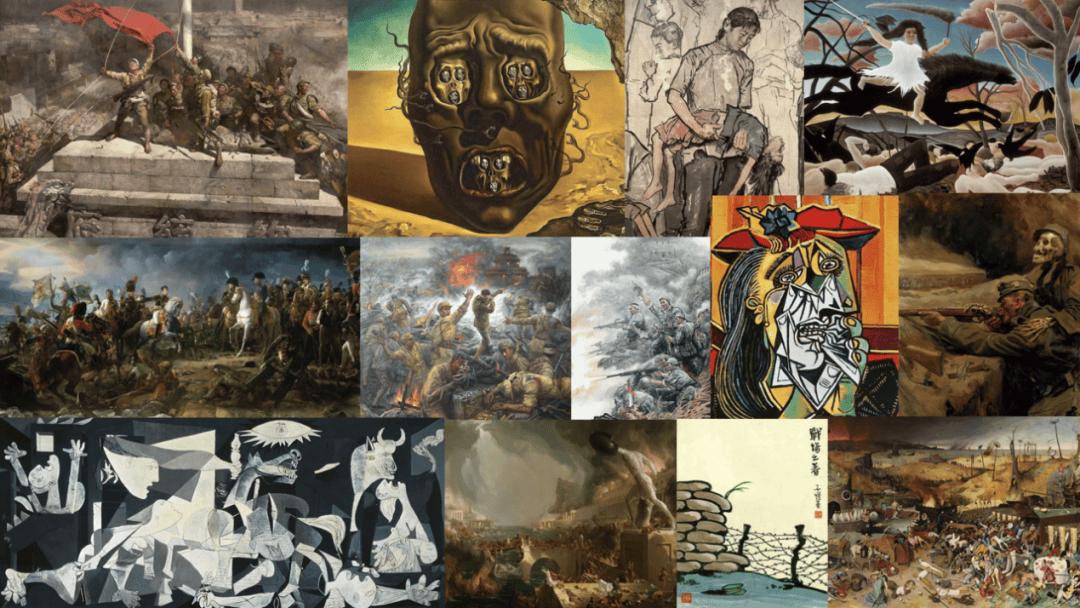
T: So today let's try to appreciate artworksthrough two famous paintings. Okay?Now look at the first one, "Guernica" by Picasso.

Just pay attention to the big screen. It is so big, right? The real size of "Guernica" is as big as what we can see now, so it is quite big when we stand or sit next to it, just like this, right? So we are quite small compared to it. What's your first impression of this picture? First impression, how do you feel?
S4: I think the picture is about aggression.
T: About aggression, right? Okay, sit down, please. And what can you see in the picture? Can you see some little things? For example, this one? Yeah, a kettle, and whatabout this one? Yes, a horse and maybe this one, light, of course. And how about the second one “The Battlefield in Spring”? How do you feel? Do you feel the same as the first one? No, why? Because it has bright colors, right?
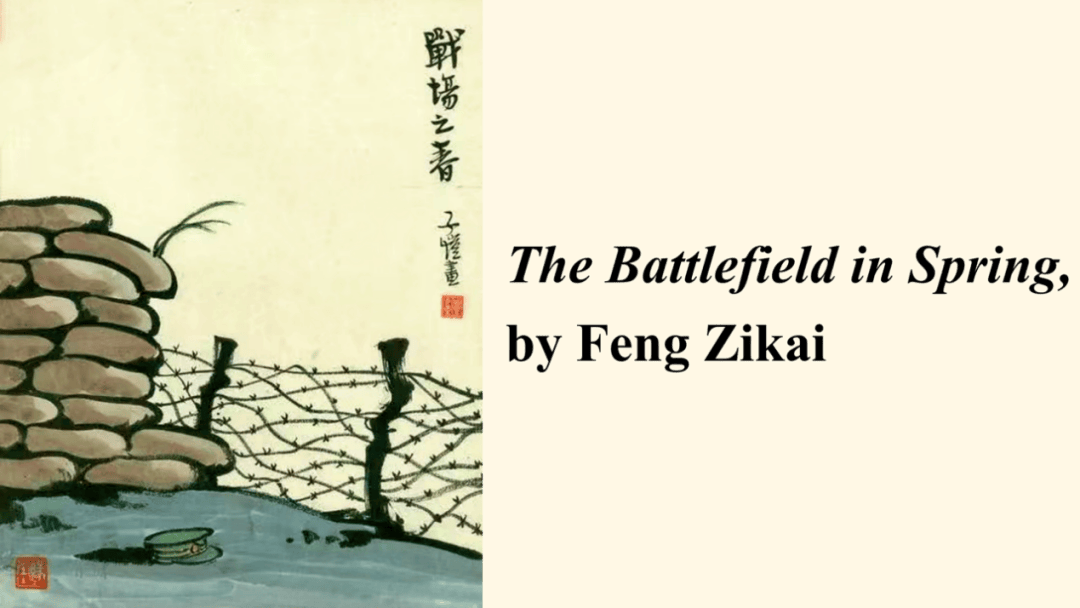
T: And what can you see in the picture? Do you know this one? Yes, a wire fence. And how about this one? Yes, maybe some stones. And how about here? Yes, grass. And the last thing. Yes, a hat.So this picture, maybe the title “the battlefield in spring” is easy for us to understand. But do you know something about "Guernica"? Do you know about it, yes or no? No, it doesn't matter. So now let's watch a video to know about more background information about Guernica.
T: Okay, after watching the video, we know the cruelty of war, right? Yes, now let's listen to the audio guide and find out what message the artists want to convey in their artworks. Please take out your worksheet and pay attention to Activity 3. While listening, please write down main message you can hear in Activity 3. Okay, let's begin.
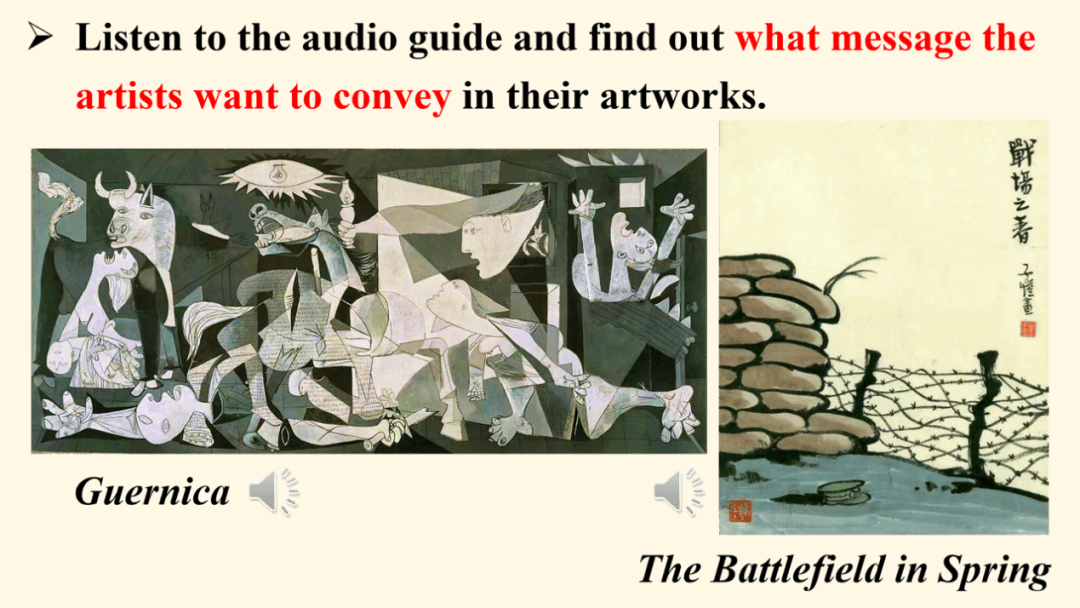
T:Okay, so what about the main message of the first painting?
S5: Hate the war.
T: Yes, to show that the artist hates the war, right? Okay, and now let's move on to the second one.
T: Okay, so what message Feng Zikai wants to convey? Do you know about it?
S6: He believes that Chinese will winthe war.
T: Yes, he believes Chinese will win, right? Yes, okay, now let's move on to activity 4, listen again for more details. From the text in activity 4, we can see the man and the woman are appreciating the artworks from these three aspects. Right, the first one. Three aspects. The first one. Basic information. And the second one? Yes, what do you see? And the lastone? How you feel? Now you have 40 seconds to read the text carefully before listening. Okay? Read this text carefully. Okay, time is up. Now let's listen for details.
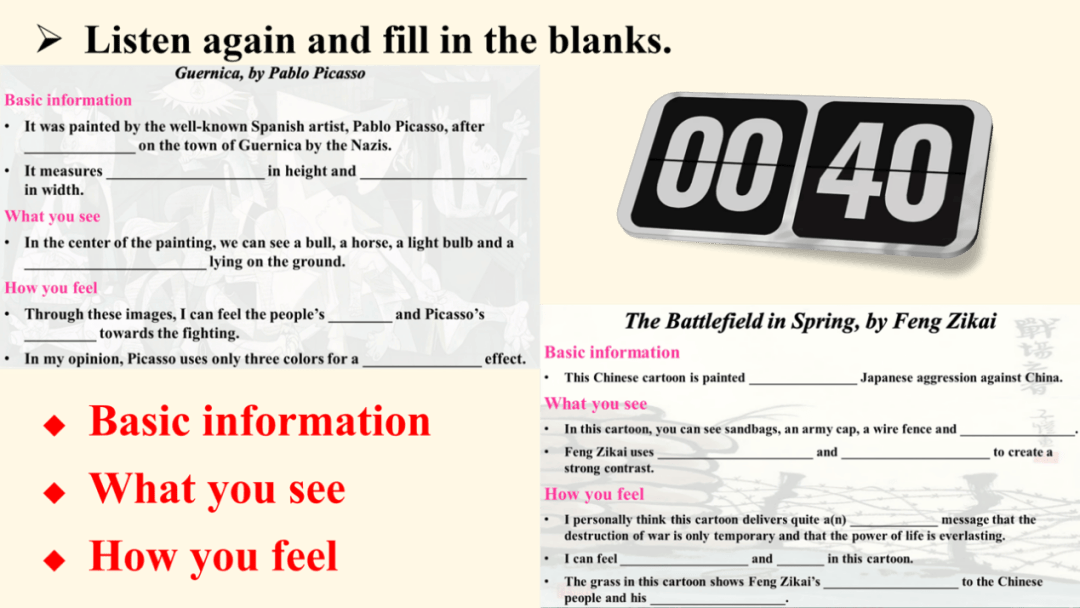
T: Okay, now let's check the answers together. The first one.
S7: The attack.
T: Yes, the attack. No. 2.
S8: 2.3.
T: 2.3. Do you agree with her? No, now let's check the answers.So clearly?3.5.Yes, 3.5 meters in height and...
T: Not clear enough? One more time.
S8: 8 meters in width.
T: Very good, 8 meters. Next one.
S9: A dead and wounded man.
T: Yes, a dead or wounded man. Next one about how we're feeling.
S10: Fear and anger.
T: Yes, fear. People feelfear and Picasso's anger. The last one.
S11: More powerful effect.
T: Yes, a more powerful effect.
T: So the first picture, clear enough?Now let's check the answers of the second one.
S12: To protect.
T: To protect. Do you need one more time? Yes.
S12: It's is printing to protest.
T:Yes, it is painted in protest of…Okay, No. 2. Not clear enough? So let's listen again.
S13: The grass leaves.
T: Yes, growing some grass leaves. Next one.
S14: Maybe the grass leaves.
T: Maybe the grass leaves, yeah. Yes, that is right. But how about the first blank? Not clear. Yes, one more time.
S14: Lifeless objects.
T: Yes, lifeless objects, and the grass leaves. Okay, next one, how do you feel?
S15: I can feel the strong spirit and hope in this cartoon.
T: Did you grasp the word clearly? “optimistic” Yes, very good, okay. Next one, I can feel?
S16: Strong spirit and hope.
T: Yes, very good. Strong spiritand hope. And the last one, the grass and the cartoon expresses what?
S17: The artist’s encouragement.
T: And his what?
S18: For peace.
T: Yes, his hope for peace, very good.Now from Activity 4, we can see the man and the woman described the artwork via some expressions in yellowon the worksheet.
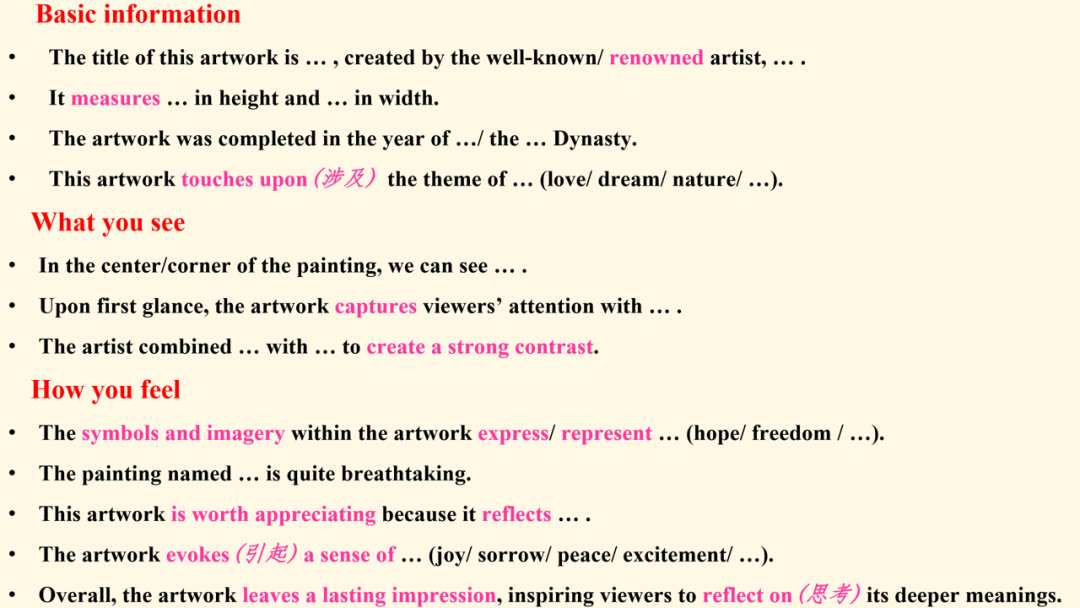
That is to say, we can also describe artworkswith the expressions from these three aspects. For example, when we want to talk about basic information, we can talk about its title. Its artist. It's date. It's scene and so on, right? And when it comes to what you see, we can talk about its color. Its style. And its image. And about the last one, how you feel? We can talk about our feeling, our impression. And even our reflection? Okay, so now you can refer to and use the expressions on the screen to describe the artworks.Now here are four famous paintings for you. The first one, 《千里江山图》by Wang Ximeng,And the second one, the Starry Night by Van Gogh.The next one is Fuqin by Luo Zhongli.And the last one, the Persistence of Memory by Dahi.Now you have several minutes to choose one of the paintings and discuss with partners with the words on the screen, okay? And then make a presentation to show us how you appreciate the art, okay? Okay, now let's begin to discuss.
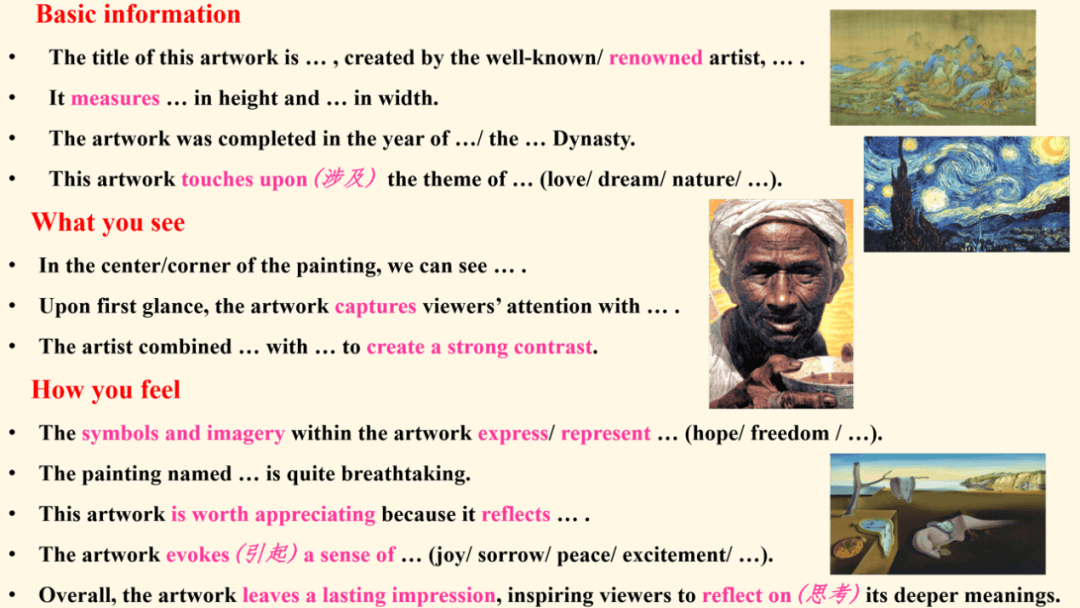
T: Okay, sorry to bother you, but time is up. So the first group, volunteer?Okay, the girl, please, which one would you like to choose?
S19:千里江山图.
T: Okay, the first painting.S19: ...
T: Yes, embrace the nature and enjoy life. Very good, sit down, please. And how about the color in this painting? Mainly blue and gray, very good. Okay, how about this group?
S20: ...
T: Yes, especially peasants, the figure in the picture, right? Yes, sit down, please. And how about the next group?
S21: ... T: So it shows a sense of lonely and it is fullof time, right? Okay, next group, any volunteers? How about yougroup? S22: ... T: And the main color of this artwork is green and blue. Maybe yellow and brown, right?It is very long, right? Yes, okay, that's all, yes, okay, thank you, sit down please.
T: So from this paintings, we know art is very important in our life, not only because it can keep us hopeful, but it also makes us less lonely because we often share the same souls with the artist, right? Yes, and they can help us appreciate every little thing in the life. The most importantly, it tells us what really matters.
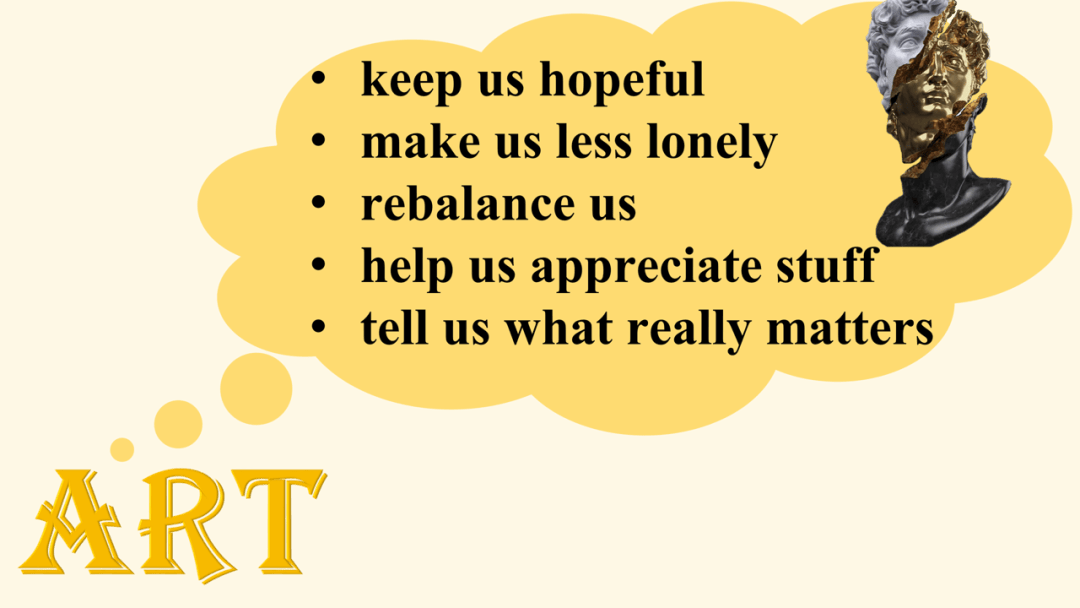
T: And nowadays with the development of technology, we can even experience a digital version of 清明上河图. We can see the characters move around and interact with the surroundings.We oftensay art imitates life and it goes beyond the life. So from this lesson on, let's “Meet the muse”. Let's meet themuse. Appreciate the art and embrace the life.
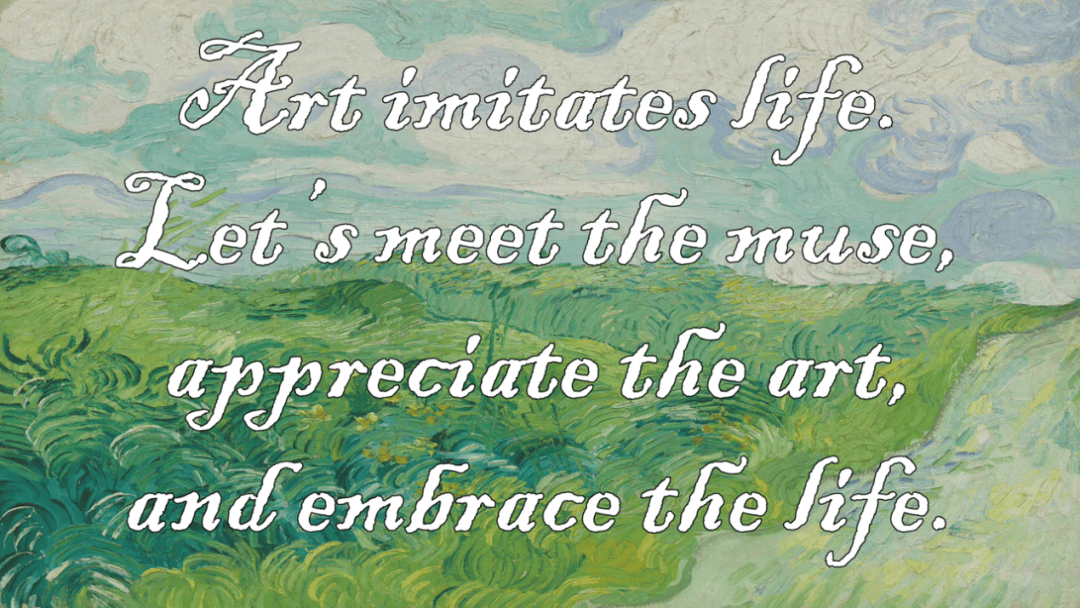
T: Okay, so today's homework, write down your appreciation of the chosen artwork, visa expressions we have learned today, okay? Class is dismissed. Thank you for cooperation.
今天的分享就到这里啦!下期再见!
通过网盘分享的文件:
链接: https://pan.baidu.com/s/1sx-tnEbSyESE0NDqOMaDbg?pwd=6666 提取码: 6666
来源:Kethrine的教学笔记
明师俱乐部进行编辑整理,版权归原作者所有,如有侵权请联系删除
明师投稿箱
欢迎您把自己的英语教学经验方法、优质教学设计案例、教育心得等和大家分享,可成为明师国际教育研究院的签约作者,更有机会被收录到《明师说》系列正式出版,与40万英语教师共同进步,快来投稿吧!
投稿邮箱:mingshijiaoyanbu@163.com,邮件命名为“投稿+作者姓名+手机号”
教学资源、精彩活动、趣味互动
福利折扣、在线咨询
湖南、福建、川渝、浙江
山东、江苏、安徽、江西
北京、上海、山西
河北、河南、天津
湖北、广东
陕西、内蒙
其他地区
请按地区添加明老师, 不要重复添加





